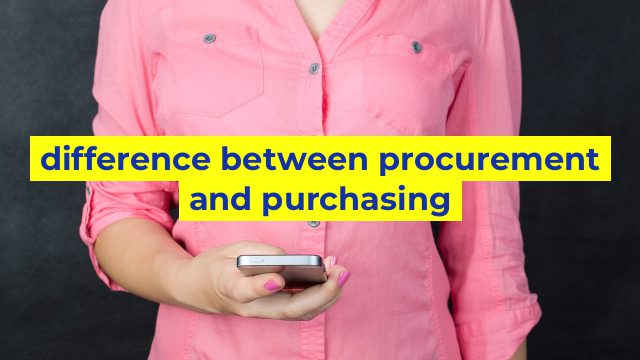Understanding the Difference between Procurement and Purchasing
When it comes to managing supplies within an organization, the terms procurement and purchasing are often used interchangeably. While both are vital for securing goods and services, they are not the same thing. It is essential to understand the differences between procurement and purchasing to optimize the procurement process and achieve optimal results.
Procurement
Procurement refers to the whole process of acquiring goods and services in an organization. It involves the identification of the need for goods or services, selecting the right supplier, negotiation, contracting, and delivery or receipt of the goods or services. In other words, procurement involves the entire supply chain management process from start to finish, focusing on identifying the right suppliers, negotiating the best terms and conditions, and ensuring quality control.
Procurement ensures that an organization gets what it needs at the right time, from the right source, and at the right price. It involves strategic thinking, collaboration, and planning to achieve long-term success. Procurement considers factors such as supply chain risk management, supplier development, and innovation to create sustainable value for the organization.
Purchasing
Purchasing, on the other hand, is a subset of procurement. It involves the transactional process of acquiring goods and services from suppliers. It mostly takes place after procurement has determined what to buy and from whom. Purchasing involves the issuing of a purchase order, receipt of goods or services, invoice processing, and payment. In essence, purchasing is the action of buying goods and services in the short term from a specific source at a particular price.
Purchasing aims to ensure that an organization gets what it ordered, when it ordered it, in the right quantity, quality, and at the right price. It is transactional in nature and involves the operational aspects of the supply chain to ensure that the organization receives what it needs at the right time.
Conclusion
While procurement and purchasing share some similarities, they are different processes that work together to achieve common goals. Procurement is strategic, collaborative, and focuses on the entire supply chain. On the other hand, purchasing is transactional, operational, and focuses on a specific buying transaction. Understanding the difference between procurement and purchasing is essential to ensure that an organization has the right procurement strategy and the right purchasing process in place to succeed in the long run.
Table difference between procurement and purchasing
| Procurement | Purchasing |
|---|---|
| Procurement involves the entire process of finding, selecting, and acquiring goods and services necessary for a company to operate. | Purchasing focuses on buying specific products or materials needed to complete a project or meet immediate needs. |
| Procurement is a strategic function that involves analyzing and managing suppliers, negotiating contracts, and selecting vendors. | Purchasing is a tactical function that involves ordering, receiving, and paying for goods and services. |
| Procurement supports the long-term goals of a company by managing the entire supply chain and establishing relationships with vendors. | Purchasing supports the short-term goals of a specific project or department by obtaining the necessary supplies and materials. |
| Procurement involves a wider range of activities, including supplier relationship management, contract management, risk management, and strategic sourcing. | Purchasing primarily involves activities like identifying suppliers, negotiating prices, and placing orders. |
| Procurement plays a key role in ensuring the quality and sustainability of products and services. | Purchasing focuses on obtaining products and services at the lowest possible cost while maintaining quality. |


